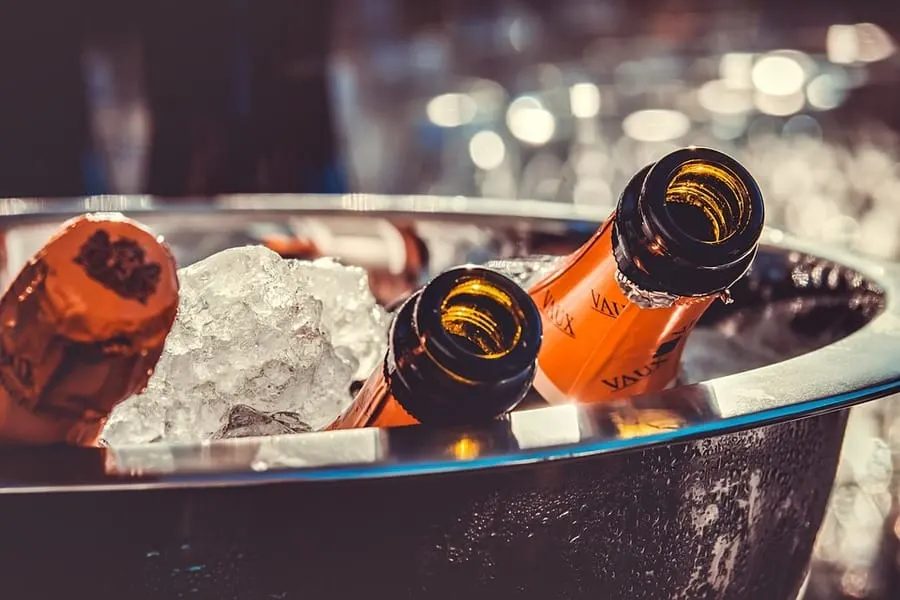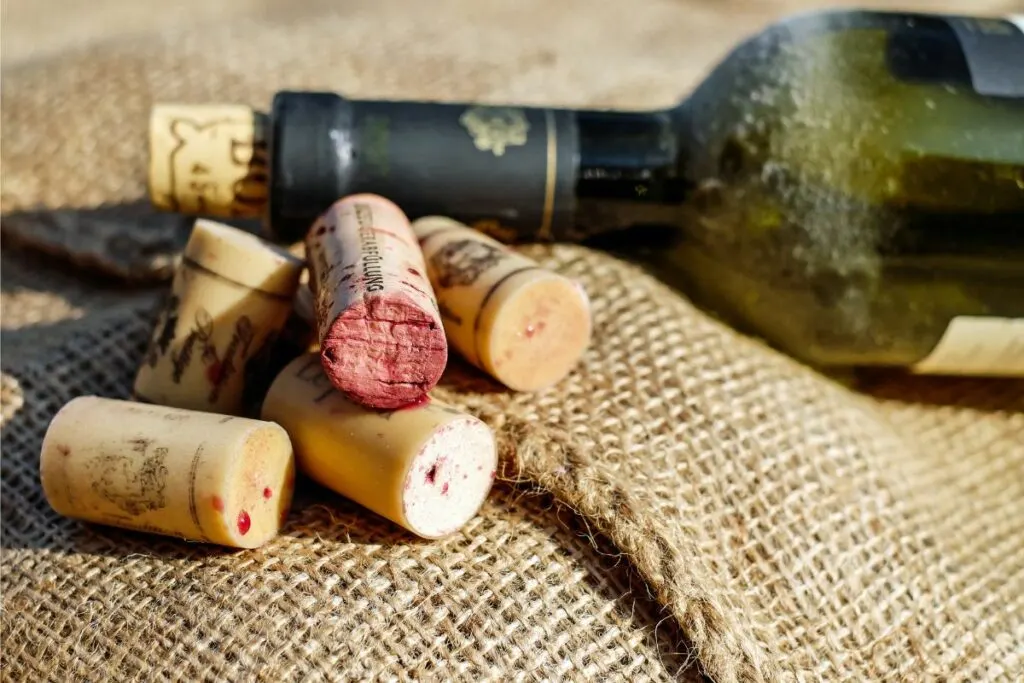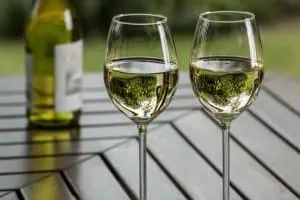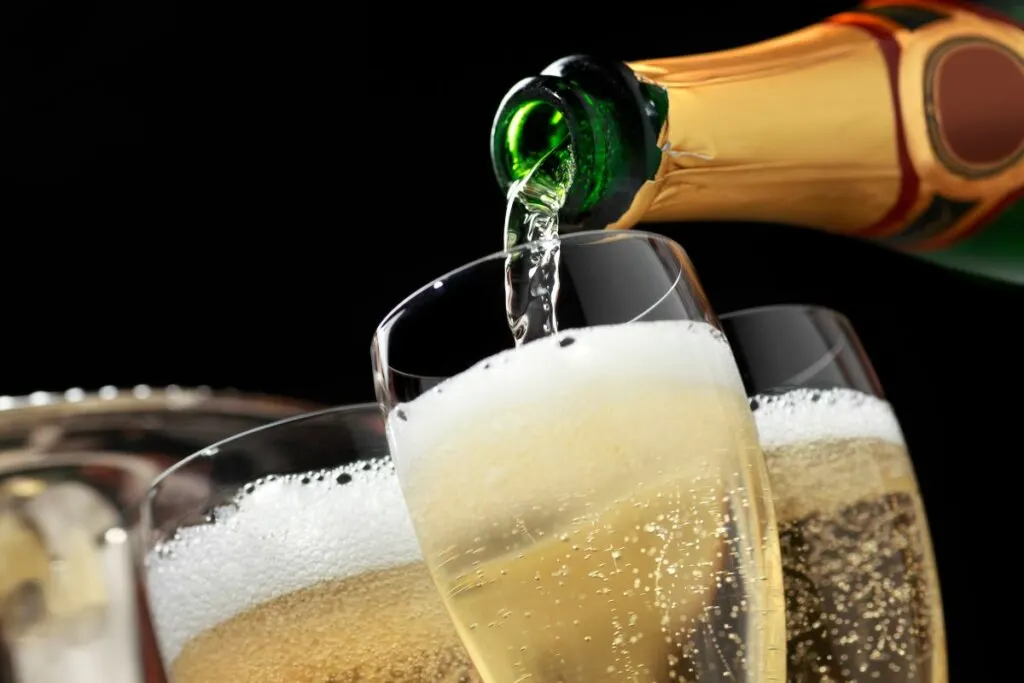As an Amazon Associate, I earn from qualifying purchases with no additional costs for you.
You’ve been running errands for a couple of hours and intended to pick up the sparkling wine for tomorrow’s brunch last, but you just realized that you forgot a couple of things at the grocery store. You figure it’s no problem. You’ll be in and out, right? Wrong. By the time you get back to your car, it’s blistering hot in there.
Does champagne go bad in the heat? Like any wine, sparkling can be ruined by heat. If you try to hold the bottle and it’s hot to the touch, chances are pretty good that your wine has been cooked, and you don’t want to serve it to your guests. If the bottle is warm and the cork hasn’t raised from the top of the bottle, you have probably avoided a mess.
Wines can cook at 80 degrees Fahrenheit and higher, which affects the taste. In addition to the exposure to temperature, direct sunlight can kill the flavor in your bottles. Before any more champagne unnecessarily goes kaput, let’s talk more about salvaging your bubbly.

TIP: If you want to check out the best refrigerator for wine storage, I recommend trying out the Avation (18 bottles) compressor refrigerator with Wi-fi smart app control cooling system. You can find this refrigerator by clicking here (Amazon link).
What to Do When Your Sparkling Wine Gets Too Hot
Let’s get back to the champagne in your car. One way to prevent this is to place a cooler of ice in your car when you know you’re running several errands and need to pick up some heat-sensitive items – bubbly, chocolate, ice cream, you get the idea.
Absent being able to do that, take the following steps when you get home:
- Look at the base of the cork.
Has the cork lifted from the top of the bottle’s neck? If it has, the cork is near popping off the bottle (if it hasn’t already). The pressurized bottle and the heat have had an adverse reaction causing the impending explosion.
At this point, if the cork hasn’t already popped, your sparkling wine has been exposed to oxygen and has started going flat.
If the cork hasn’t lifted, store the wine on its side in a dark, cool room for 30 days. At the end of the month’s waiting period, chill your sparkling wine for a couple of hours before you plan on serving it.
The fact is that you’re in a crapshoot in this scenario, so you probably don’t want to plan on serving this bottle during an important dinner party.
- Open the bottle.
If your sparkling wine has gone bad, there are several things you can look for:
- It’s flat. If the heat adversely affected your champagne, you’ve probably lost the bubbles in your bubbly.
- It’s not a clear/light color anymore. If your champagne has changed color and is not a deep yellow or dark gold.
- It doesn’t smell appealing. If your beverage smells or tastes sour, it has gone bad.
You can still drink your wine if any of the above has happened, it just won’t taste like the wonderful sparkling wine you were expecting.
If your bubbly has simply lost its bubbles, but the taste is still good, you might want to think about using it for cooking just as you would use any wine in a sauce or dish. You could also consider making your own champagne vinaigrette salad dressing.
You can even make your vinegar from your flat champagne by pouring it into a mason jar and tightly covering it with a few layers of cheesecloth. After about six months of sitting in a cool, dark place, you will have your champagne vinegar.
Once you pop the cork, most wines go bad within a day or so. But a Coravin Wine Preservation system (available for a great price on Amazon) can extend the life of your opened wine for weeks or even months. It is awesome. You should check it out and see if it will fit into your lifestyle.
Can You Rechill Champagne?

Let’s say you opened a magnum of sparkling wine and didn’t drink the whole thing. Do you just need to throw the rest of the bottle out or suck it up and drink the rest of it?
The answer to both of those questions is an unequivocal no. You absolutely can reseal and re-chill your leftover champagne for a few days. There is no need to waste your bubbly; you just need to know how to store it in a way that preserves its flavor and bubbles.
3 Ways to Reseal Your Open Bottle of Sparkling Wine
You can reseal your bubbly, and it will keep for an additional three or four days. It won’t be as bubbly as when you first opened the bottle, but it will retain some of its fizzes. Here are three different methods you can use:
- Recork it.
This may be challenging as the cork will expand as soon as it is released from the bottle, but, with effort, you can get the cork reinserted into the bottle.
- Use a champagne cork – may also be called a champagne stopper.
These are fairly inexpensive investments that can help save you from feeling that you’re wasting your special beverage. The OWO Champagne Stopper, for example, sells for about $9. Several different options on the market range from utilitarian to cutesy novelty items.
TIP: Are you interested in buying a wine stopper? We’ve personally tried and recommend buying one of these wine stoppers (Amazon links):
- The Original Vacu Vin Wine Saver: Our top choice. Very easy-to-use wine stopper/saver. You can enjoy a glass of fresh wine whenever you want without worrying about wasting any.
- EZBASICS Wine Saver: Great alternative to Original Vacu Vin Saver. This wine stopper keeps the flavor of wine for up to one week.
- Champagne Stopper by MiTBA: Wine stoppers for sparkling wines are different. This wine stopper seals your bottle and increases the pressure so your beverage’s bubbles won’t go to waste.
- Use some plastic wrap – not aluminum foil.
A quick and easy solution is to tightly cover the top of the bottle with cling wrap and secure it with a rubber band. The cling wrap will allow you to get a tight seal, but aluminum foil is too stiff and will result in increases that allow air in and cause your bubbly to go flat faster.
If you want to cool your wine properly, a wine fridge is a great investment. This is one of the very best models currently available for a low price on Amazon. It is great for reds, whites, and even sparkling wines like Prosecco. Check it out to read real customer reviews.
Is It Champagne or Is It Sparkling Wine?

As a society, we tend to use the term “champagne” pretty loosely. The reality is that all bubbles are not created equal.
Just as copyrights and trademarks are protecting various brands – Lindor Chocolates™, for example, for a wine to be branded as champagne, it must come from that specific, small region in France.
In addition to coming from the Champagne region, which hosts six elite winemakers, those who wish to create this sparkling wine must also follow a rigorous process.
There are winemakers outside of Champagne, France that follow this arduous process, but because their grapes are not grown in the coveted soil in the Champagne region, they cannot claim the brand.
TIP: Is sugar needed to make great wine? Find out here. You can buy certain wines directly from the vineyard. Read this guide to find out how.
The Rigorous Process to Develop Champagne (or Sparkling Wine)
Two different processes are used to create sparkling wine. First, we’ll discuss what is required for legitimate champagne.
- Champagne
This sparkling wine is created from a blend of three grapes – Chardonnay, Pino Noir, and Pinot Meunier grown in the Champagne, France region.
Creating the wine via the Méthode Champenoise (Traditional Method) involves a second fermentation process inside the bottle.
- Sparkling Wines
Even though winemakers all over the world strictly adhere to the traditional method for creating and bottling champagne, they use their grapes or grapes grown outside of the Champagne region, which renders them unable to claim the champagne label.
Other winemakers, like the Italian makers of Prosecco, use the “tank method.” During this process, the second round of fermentation takes place in a tank rather than in an individual bottle. It is more efficient and makes more sense for large batches but takes away from the prestige of the original process.
Our Sparkling Wines “Less Than” Champagne?
There are two different ways to interpret this question:
1. Does sparkling wine cost less than Champagne?
Not necessarily. There are non-vintage champagnes that are bottled to be affordable table wines – Costco Champagne is an example. The Costco brand is a real Champagne made by a reputable winemaker in the appropriate region and it typically costs about $20 per bottle.
There are also vintage sparkling wines that are from a particularly good crop and, therefore, have limited availability and have a higher price tag – Ferrari Riserva Lunelli Metodo Classico 2006 is one of these – it typically retails for nearly $90 per bottle.
Granted, the most expensive of all sparkling wines are the French vintage Champagnes – a bottle of 2002 Dom Perignon will set you back about $400.
2. Is sparkling wine less prestigious than champagne?
In wine circles, the answer is a resounding yes. That said, you need to decide how important that is to you. Many sparkling wines are made following the same demanding process that the wines from Champagne are.
They have a wonderful flavor and provide a lot of enjoyment. Another thing to consider is that if you are going to mix your bubbly with another item – orange juice for mimosas, for instance, you wouldn’t want to waste the subtlety of a fine Champagne – the orange juice will overpower the mild flavor.
If what you want is the power of name recognition, by all means, go for the Dom or the Cristal.
TIP: Is Sparkling wine different from Champagne? Find out in this article. Discover the differences between cheap and expensive wines here.
Champagne: Vintage vs. Non-vintage

Is calling something vintage or non-vintage simply a marketing tool to be able to charge more for a bottle of bubbly? No. There is a legitimate difference between the two.
Vintage wines hold more prestige in the wine community because they:
- Contain the top grapes from a single year’s harvest of the three types of grapes used in a true Champagne, which means there are fewer grapes available, and therefore, they are at a premium.
- Have been aged in the bottle for a minimum of three years and can last 10 years, and in some cases beyond, when it was released to the market.
Non-vintage wines have the opportunity for some different qualities because they:
- Contain a blend of grapes from different harvests spanning multiple years, allowing for some interesting notes that may not be as complex as a vintage year.
- Generally, have a crisper, fresher taste because they age for about 18-months as opposed to the three years a vintage would typically age before being released to the market.
- It can be safely stored and used for about four to five years of when it was bottled.
How Do I Know Which Champagne or Sparkling Wine to Buy?
Regardless of whether you are going to drink a vintage or a non-vintage sparkling wine, you have some decisions to make as to what sweetness level you prefer. Part of this decision may have to do with whether or not you’re serving the champagne with a meal, dessert, or as an aperitif.
Sparkling Wine by the Sugar and Pairing
To help you decide what you’re looking for, here are the seven typical levels of sweetness you can find on the market.
- Brut Nature
This is preferred by many wine connoisseurs. At this level, the yeasts in the fermentation process have eaten nearly all of the natural sugar leaving only 0-3 g/L (grams of sugar per liter) of residual sugar in the wine. If you want to serve a cheese platter, this will pair perfectly with it – particularly if you are serving stronger cheeses.
- Extra Brut
If you find Brut Nature a bit too dry for your taste, you may like this better. Extra has somewhere between 0-6 g/L of residual sugar remaining in the wine. If you want something to serve with your caviar, this is what you want to look for.
- Brut
This is a very popular level preferred for many celebrations. While this sparkling wine is still dry, it has a slight hint of sweetness because the winemaker intervenes in the fermentation process before the yeasts have eaten all of the sugar. This level will typically be labeled at 0-12 g/L as is often paired with mild cheeses such as brie or sweetbreads and mascarpone.
- Extra Dry
Based on the name, it seems counterintuitive, but this level is less dry and sweeter than the others. It’s not overwhelmingly sweet, though. Prosecco is usually bottled at this level. The Extra Dry sparkling wine typically has 12-17 g/L. If you’re looking for something to pair with light items such as sushi, shrimp cocktail, smoked salmon, almonds, or asparagus, this is a good bet.
- Dry
At 17-32 g/L, this sparkling wine is a wonderful aperitif. It has enough sugar content to encourage appetite without being too sweet. The Dry is usually paired with salty or buttery snacks.
- Demi-Sec
This level of sweetness is usually served with a light dessert. Its sweetness pairs nicely with something sweet but don’t go over the top. The Demi-Sec is typically labeled at 35-50 g/L.
- Doux
If you have a serious sweet tooth and want something to pair with an incredibly decadent dessert, this is your bubbly. The Doux is bottled at 50+ g/L. That’s some serious sugar content.
TIP: A suitable wine glass is the basis for enjoying well-being while drinking your favorite wine variety. Here are our favorite ones (Amazon link):
- Bormioli Rocco Crystal Wine Glasses: A set of eight elegant and traditional wine glasses made in Italy for a reasonable price.
- Riedel VINUM Wine Glasses: Luxury set of two wine glasses suitable for any occasion. We just love them!
- Schott Zwiesel Tritan Crystal Glasses: If you like unusual alternatives, a set of six stemless glasses made of crystal glass.
Champagne by Another Name

We already know that a true Champagne is from the Champagne region of France, but what about sparkling wines from other regions? Let’s talk about some different types of sparkling wine that are on the market.
- Cava
Cava comes from Spain, and its most famous sparkling wine production can be found in Penedès. Although Cava uses the same traditional method that Champagne uses in production, it uses indigenous grapes such as Macabeo, Parallada, and Xarel-lo.
You’ll be able to find varieties of Cava in either white or rosé versions that will range from Brut to Doux in sweetness level.
- Cremant d’Alsace
This German wine is more difficult to find than its Spanish cousin. It is typically available in both a white and rosé variety. Although it also uses the prestigious process used in Champagne to produce the sparkling wine, it may have a wider variety of grapes used in the process.
You may find diverse blends of Auxerrois Blanc, Chardonnay, Pinot Blanc, Pinot Gris, and Riesling in the German sparkling wine which gives it a slightly different, but delightful, bouquet.
- Prosecco
The Italians have found a way to mirror the Extra Dry Champagne in a way that is both pleasing and affordable. By overseeing the second fermentation process in stainless steel tanks rather than individual bottles, this bubbly becomes less expensive. This process also emphasizes the fruitiness of the Glera grape used in the process.
- California
The Californian winemakers have found the perfect middle ground between Champagne and Prosecco. You can find sparkling wines with all of the complexities of Brut Nature through the entire sweetness spectrum.
The French are so impressed with what has come out of California that there are a few of the famous French Champagne houses that also have sparkling wine operations in California.
Recommendation box: Everything you need to enjoy your wine as much as possible. All recommended products are personally tested and regularly used by experts from this website (Amazon links):
> Ivation Wine Cooler – Energy-efficient wine cooler for 18 bottles with Wi-fi smart app control cooling system.
> Wine Rack – Beautiful, elegant wood rack for up to 7 bottles and the choice of vertical or horizontal storage.
> Durand Wine Opener – Classic vintage wine opener (we like all these classic staff).
> YouYah Iceberg Wine Decanter – The most beautiful and handy wine decanter we personally use.
> Bormioli Rocco Wine Glasses – A set of eight elegant and traditional wine glasses made in Italy.
> Vintorio Wine Aerator – Simple but really useful wine aerator for a reasonable price.
> The Original Vacu Vin Wine Saver – The best wine saver on the market in a package with two vacuum stoppers and two wine servers.
And if you want to become a true connoisseur of wine, we recommend reading the book Wine Folly: The Essential Guide to Wine (Amazon link), where you will find all the information you need about winemaking, wine varieties, flavors, and much more.
In Conclusion: Champagne & Heat Exposure
If your sparkling wine or Champagne gets hot, it may be salvageable as long as the cork hasn’t lifted – can you imagine the horror of coming back to your car to have it covered in sticky bubbly because of the heat caused it to uncork?
If your sparkling wine just got warm, allow the bottle to lower to room temperature, then you’ll be able to quickly chill it by filling a bucket (or your kitchen sink) with a 50/50 mix of ice and water.
The water is important because the ice will conduct the cold through the water and that will result in a faster and more thorough chilling process.
Regardless of whether you have bought some traditional Champagne or one of its sparkling cousins, you will be able to enjoy the delicate bubbles and light taste.
TIP: Check out this page for a complete list of wine products and accessories I love. You’ll find my recommendations for wine refrigerators, decanters, and aerators and the best place to buy wine online. Click here to see the complete listing.
